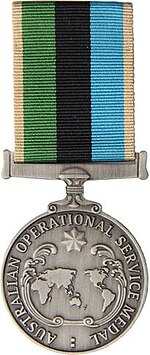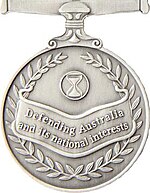Loading AI tools
Award From Wikipedia, the free encyclopedia
The Australian Operational Service Medal is a campaign medal established on 22 May 2012 to recognise service by Australian Defence Force (ADF) personnel on designated hazardous operations. It may also be awarded to civilians who serve alongside the ADF on designated operations under specific conditions.
| Australian Operational Service Medal | |
|---|---|
  Australian Operational Service Medal with: "Border Protection" ribbon (top) and "Greater Middle East Operation" ribbon | |
| Type | Campaign medal |
| Awarded for | Service on declared hazardous operations |
| Presented by | Australia |
| Eligibility | Military – Willingly and ably perform their work as part of an operation or within other specific hazardous environments and conditions. Civilian – Defence civilians, and other classes of civilian who are employed on ADF operations under the provisions of the Defence Force Discipline Act 1982.[1] |
| Clasps | "accumulated service device" for military awards[2][3] Clasps for operations for civilian awards[2][4] |
| Status | Currently issued |
| Established | 22 May 2012 |
| First awarded | 12 December 2012[5] |
 Reverse | |
| Order of Wear | |
| Next (higher) | Australian Service Medal |
| Next (lower) | Rhodesia Medal |

It replaces the Australian Active Service Medal and Australian Service Medal for future ADF operations. The medal is issued to military personnel with a different ribbon for each designated operation. When issued to civilians, a standard ribbon is issued with clasps issued for each designated operation.
The Australian Operational Service Medal is a campaign medal established by Royal Letters Patent on 22 May 2012.[6] This campaign medal was instituted as a replacement for future issues of the Australian Active Service Medal and Australian Service Medal and operational campaign medals for the Australian Defence Force, as well as to recognise the service of Defence civilians in declared operational areas.[7] It is awarded as either a military or civilian variant.[8]
The military version of the medal has a standard medal design, but ribbons vary by operation.[3] An accumulated service device will be awarded for subsequent qualifying service by ADF members where they undertake further service on an operation for which they have already been awarded the Australian Operational Service Medal.[3]
To date, four ribbons for ADF service have been announced:
| The Border Protection ribbon has three equal stripes of dark blue, ochre and dark green which denote the seas and sky, the deserts, and the forests and grasslands.[9] | |
| The Greater Middle East Operation ribbon has three equal stripes of mid green, black and light blue, edged by two slim stripes of light sand. Sand represents the desert sands, green represents Australia and hope, black represents anti-piracy, and blue represents the maritime and air aspects.[10][11] | |
| The Special Operations ribbon is 32 mm wide in black with a central stripe of red. Additional accumulated service is denoted by an 8 mm high Arabic numeral with an antique silver finish.[12] | |
| The Counter Terrorism/Special Recovery ribbon is 32 mm with black edges, symbolising counter-terrorism operations fading to grey to symbolise the urban nature of operations. The blue stripes, which flank the central white stripe, represent the broader contribution of the Special Operation command staff. The white symbolises the peaceful outcome as a final action.[13] | |
| The Africa ribbon is 32 mm as a central red stripe, flanked by black stripes of equal width, bordered with golden yellow and White stripes of equal width and edged with mid-green stripes.[14] |
The Australian Operational Service Medal (Civilian) was established to allow for recognition of Defence civilians, who had agreed to be subject to the Defence Force Discipline Act 1982 and were employed overseas to support the operations of a deployed military force in a declared area of operations. The civilian version uses the same medal design as the military version, but is awarded with a unique civilian ribbon and a clasp denoting the declared operation.[15] Subsequent qualifying service for civilians will be (is) denoted by clasps.[15]
| The Civilian ribbon is green with central stripes of gold and purple. The purple represents Defence, and the green and gold are Australia's national colours. |
Clasps announced (and awarded) to date are listed below.
The variant for border protection operations was announced on 19 July 2012. This variant will be (is) awarded to Australian Defence Force personnel who have served on border protection operations since 1997. The ribbon for the medal is 32 mm wide with a central stripe of ochre flanked by one blue stripe and one green stripe of equal width.[16]
The declared operations are:
| Operation | From | To | Notes |
|---|---|---|---|
| CRANBERRY | 1 August 1997 | 16 July 2006 | [16][17] |
| DIRK | 1 September 1997 | 31 October 1997 | [16] |
| STANHOPE | 3 February 1998 | 6 March 1998 | [16] |
| MISTRAL | 1 August 1998 | 30 June 2006 | [16] |
| TEEBONE | 1 March 2001 | 31 March 2001 | [16] |
| CELESTA | 1 August 2001 | 31 July 2006 | [16][18] |
| SUTTON | 25 January 2002 | 19 February 2002 | [16] |
| GEMSBOK | 29 August 2003 | 3 October 2003 | [16] |
| RELEX | 3 September 2001 | 13 March 2002 | [16] |
| RELEX II | 14 March 2002 | 16 July 2006 | [16][19] |
| RESOLUTE | 17 July 2006 | ongoing | [16][20] |
Personnel who served on naval vessels, maritime patrol aircraft or Regional Force Surveillance Unit patrols whilst assigned to any of these operations may be eligible.[21]
Members of the Australian Defence Force must have served either an aggregate of 30 days either deployed or force assigned as a member of one of the declared operations, or were deployed or force assigned to a declared operation and completed 30 sorties from a unit assigned to the operation, so long as the sorties were conducted over a period of not less than 30 aggregate days with no more than one sortie counted per day.[16]
Members must also have been:[16]
Members are not eligible for an award of the AOSM-BP where an entitlement exists to another Australian medal for the same deployment.
Members are not eligible for an award of the AOSM-BP where the member was part of:
The eligibility requirements for this medal are:
The declared operations are:
| Operation | From | To | Notes |
|---|---|---|---|
| MANITOU | 1 July 2014 | ongoing | [22][23] |
| ACCORDION | 1 July 2014 | ongoing | [22][23] |
| HIGHROAD | 1 January 2015 | ongoing | [24] |
| OKRA | 1 January 2015 | 20 December 2024 | [24] |
| MAZURKA | 1 November 2023 | ongoing | [25] |
| PALADIN | 1 November 2023 | ongoing | [25] |
| FORTITUDE | 1 November 2023 | ongoing | [25] |
| STEADFAST | 10 September 2018 | ongoing | [25] |
The eligibility requirements for this medal are:
The declared operations are:

On 12 December 2012, the Governor-General declared, for the purposes of the Australian Operational Service Medal Regulation 2012, a number of declared operations, and determined the conditions for award of Clasps.[4]
| Theatre | Operation | Declared period | Clasp name | Notes | |
|---|---|---|---|---|---|
| from | to | ||||
| East Timor | TANAGER | 20 February 2000 | 19 May 2002 | EAST TIMOR | [4] |
| East Timor | CITADEL | 20 May 2002 | 19 May 2004 | EAST TIMOR | [4] |
| East Timor | SPIRE | 20 May 2004 | 21 May 2005 | EAST TIMOR | [4] |
| various | SLIPPER | 11 October 2001 | 1 August 2002 | ICAT | [4][27] |
| various | SLIPPER | 11 October 2001 | 30 July 2009 | ICAT | [4][28] |
| various | SLIPPER | 31 July 2009 | 19 February 2012 | ICAT | [4][29] |
| various | SLIPPER | 20 February 2012 | 30 June 2014 | ICAT | [4][30][31][32] |
| Afghanistan | SLIPPER | 1 July 2014 | ICAT | [31][33] | |
| various | FALCONER | 18 March 2003 | 22 July 2003 | IRAQ 2003 | [4][34] |
| various | CATALYST | 16 July 2003 | 31 July 2009 | IRAQ 2003 | [4][35] |
| Solomon Islands | ANODE | 24 July 2003 | 1 August 2013 | SOLOMON IS II | [4] |
| Timor-Leste | ASTUTE | 12 May 2006 | 25 May 2013 | TIMOR-LESTE | [4] |
| various | MANITOU | 1 July 2014 | ongoing | G.M.E. OPS | [36][23] |
| various | ACCORDION | 1 July 2014 | ongoing | G.M.E. OPS | [36][23][37] |
Seamless Wikipedia browsing. On steroids.
Every time you click a link to Wikipedia, Wiktionary or Wikiquote in your browser's search results, it will show the modern Wikiwand interface.
Wikiwand extension is a five stars, simple, with minimum permission required to keep your browsing private, safe and transparent.